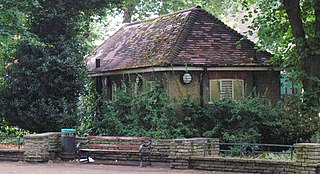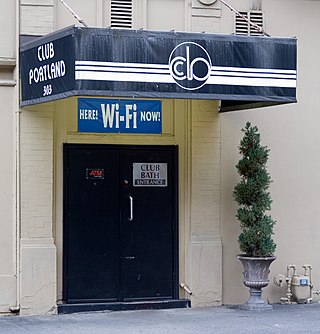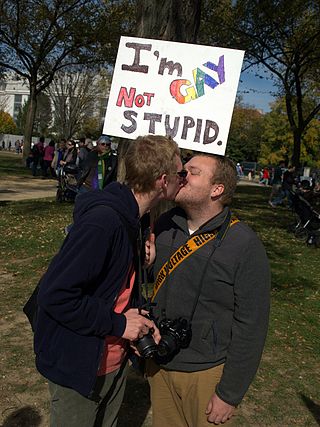Cruising for sex, or cruising, is walking or driving about a locality, called a cruising ground, in search of a sex partner, usually of the anonymous, casual, one-time variety. [1] [2] The term is also used when technology is used to find casual sex, such as using an Internet site or a telephone service. [3] [4]
According to historian and author Tim Blanning, the term cruising originates from the Dutch equivalent kruisen. [5]
In a specifically sexual context, the term "cruising" originally emerged as an argot "code word" in gay slang, by which those "in the know" would understand the speaker's unstated sexual intent, whereas most heterosexuals, on hearing the same word in the same context, would normally misread the speaker's intended meaning in the word's more common nonsexual sense. This served (and in some contexts, still serves) as a protective sociolinguistic mechanism for gay men to recognize each other, and avoid being recognized by those who may wish to do them harm in broader societies noted for their homophobia.
In the latter half of the twentieth century, decriminalization of homosexual behaviour increasingly became the norm in English-speaking countries. The protective barrier once provided by the term "cruising" as a "code word" has therefore largely broken down and, arguably, become increasingly irrelevant. Thus the specifically sexual meaning of the term has passed into common usage to include the sexual behavior of heterosexual persons, as well.[ citation needed ]
Public health officials have noted that cruising locations are frequented by men who have sex with men, but do not identify with being homosexual or bisexual, who are closeted, married, or in relationships with women, do not date men or frequent gay bars, clubs or websites, or have otherwise no other way of meeting men for sex. [6]
The cruising places are often considered meeting places for men who are otherwise living more conventional lifestyles. For instance, it was noted in Laud Humphreys' 1970 study about anonymous gay sex meeting places that most men who visited those places were at least seeming heterosexuals who had families. [7]
In the United States, the term "cruising" was used predominantly to denote exclusively homosexual behavior, but in Australia and the United Kingdom it is used by both homosexuals and heterosexuals to describe their own behavior, as witnessed in the common male heterosexual derivative phrase "cruising for chicks". [8] [9] [10]
In the United States, cruising often takes place in gay bars, adult video arcades often through gloryholes, adult movie theaters, public toilets, parks, saunas, gyms or gay bathhouses. Engaging in such activities in public places like parks has led to participants being charged with indecent exposure.
In Poland, the term pikieta (plural: pikiety; translated as "picket" or "piquet") is used to describe a similar practice. Origination around the turn of the 19th century, pickets were especially popular during the Polish People's Republic period, when homosexuality was more taboo and few people decided to be open about their sexuality. In Warsaw, one of the most prominent locations for pickets was the northern frontage of Three Crosses Square. In the early 21st century, pickets became less popular due to the development of a network of premises for sexual minorities, such as bars, discos and saunas, as well as communication via the Internet. [11] [12] [13]
Cruising for sex is alluded to in songs such as "Cruisin' the Streets" by the Boys Town Gang [14] as well as "I'm a Cruiser" by the Village People, on the album titled Cruisin' .
In 1980, director William Friedkin made the film Cruising , starring Al Pacino. The film introduced many audiences to homosexual activities and the linguistic codes used for them, but gay rights groups perceived a negative depiction of the gay community in the film and protested its production. [15]
The opening scene of the first episode of the HBO series Looking involves the main character Patrick (Jonathan Groff) cruising in a park, mainly out of curiosity of whether the activity is still in practice or not. [16]
Cruising for sex was explored in Cruising Pavilion , a 2018 art installation associated with the Venice Biennale of Architecture. [17]

Heterosexuality is romantic attraction, sexual attraction or sexual behavior between people of the opposite sex or gender. As a sexual orientation, heterosexuality is "an enduring pattern of emotional, romantic, and/or sexual attractions" to people of the opposite sex; it "also refers to a person's sense of identity based on those attractions, related behaviors, and membership in a community of others who share those attractions." Someone who is heterosexual is commonly referred to as straight.

Sexual orientation is an enduring pattern of romantic or sexual attraction to persons of the opposite sex or gender, the same sex or gender, or to both sexes or more than one gender. These attractions are generally subsumed under heterosexuality, homosexuality, and bisexuality, while asexuality is sometimes identified as the fourth category.

Bi-curious is a term for a person, usually someone who is a self-identified heterosexual, who is curious or open about engaging in sexual activity with a person whose sex differs from that of their usual sexual partners. The term is sometimes used to describe a broad continuum of sexual orientation between heterosexuality and bisexuality. Such continuums include mostly heterosexual or mostly homosexual, but these can be self-identified without identifying as bisexual. The terms heteroflexible and homoflexible are mainly applied to bi-curious people, though some authors distinguish heteroflexibility and homoflexibility as lacking the "wish to experiment with sexuality" implied by the bi-curious label. To sum it up, the difference between bisexual and bicurious is that bisexual people know that they are sexually attracted to both genders based on personal experience. Bicurious people are still maneuvering their way through their sexuality.
Promiscuity is the practice of engaging in sexual activity frequently with different partners or being indiscriminate in the choice of sexual partners. The term can carry a moral judgment. A common example of behavior viewed as promiscuous by many cultures is the one-night stand, and its frequency is used by researchers as a marker for promiscuity.

Cottaging is a gay slang term, originating from the United Kingdom, referring to anonymous sex between men in a public lavatory, or cruising for sexual partners with the intention of having sex elsewhere. The term has its roots in self-contained English toilet blocks resembling small cottages in their appearance; in the English cant language of Polari this became a double entendre by gay men referring to sexual encounters. See also gay beat in Australian English.
Down-low is an African-American slang term specifically used within the African-American community that typically refers to a sexual subculture of Black men who usually identify as heterosexual but actively seek sexual encounters and relations with other men, practice gay cruising, and frequently don a specific hip-hop attire during these activities. They generally avoid disclosing their same-sex sexual activities, even if they have female sexual partner(s), they are married to a woman, or they are single. The term is also used to refer to a related sexual identity. Down-low has been viewed as "a type of impression management that some of the informants use to present themselves in a manner that is consistent with perceived norms about masculine attribute, attitudes, and behavior".
LGBT slang, LGBT speak, queer slang or gay slang is a set of English slang lexicon used predominantly among LGBTQ+ people. It has been used in various languages since the early 20th century as a means by which members of the LGBTQ+ community identify themselves and speak in code with brevity and speed to others. The acronym LGBT was popularized in the 1990s and stands for Lesbian, Gay, Bisexual, and Transgender. It may refer to anyone who is non-heterosexual or non-cisgender, instead of exclusively to people who are lesbian, gay, bisexual, or transgender. To recognize this inclusion, a popular variant, LGBTQ, adds the letter Q for those who identify as queer or are questioning their sexual or gender identity.

A gay bathhouse, also known as a gay sauna or a gay steambath, is a public bath targeted towards gay and bisexual men. In gay slang, a bathhouse may be called just "the baths", "the sauna", or "the tubs". Historically, they have been used for sexual activity.

Non-heterosexual is a word for a sexual orientation or sexual identity that is not heterosexual. The term helps define the "concept of what is the norm and how a particular group is different from that norm". Non-heterosexual is used in feminist and gender studies fields as well as general academic literature to help differentiate between sexual identities chosen, prescribed and simply assumed, with varying understanding of implications of those sexual identities. The term is similar to queer, though less politically charged and more clinical; queer generally refers to being non-normative and non-heterosexual. Some view the term as being contentious and pejorative as it "labels people against the perceived norm of heterosexuality, thus reinforcing heteronormativity". Still, others say non-heterosexual is the only term useful to maintaining coherence in research and suggest it "highlights a shortcoming in our language around sexual identity"; for instance, its use can enable bisexual erasure.
Heteroflexibility is a form of a sexual orientation or situational sexual behavior characterized by minimal homosexual activity in an otherwise primarily heterosexual orientation, which may or may not distinguish it from bisexuality. It has been characterized as "mostly straight". Although sometimes equated with bi-curiosity to describe a broad continuum of sexual orientation between heterosexuality and bisexuality, other authors distinguish heteroflexibility as lacking the "wish to experiment with ... sexuality" implied by the bi-curious label. The corresponding situation in which homosexual activity predominates has also been described, termed homoflexibility.

Terms used to describe homosexuality have gone through many changes since the emergence of the first terms in the mid-19th century. In English, some terms in widespread use have been sodomite, Achillean, Sapphic, Uranian, homophile, lesbian, gay, effeminate, queer, homoaffective, and same-gender attracted. Some of these words are specific to women, some to men, and some can be used of either. Gay people may also be identified under the umbrella terms LGBT.

Bareback sex is physical sexual activity, especially sexual penetration, without the use of a condom. The topic primarily concerns anal sex between men without the use of a condom, and may be distinguished from unprotected sex because bareback sex denotes the deliberate act of forgoing condom use.

In Australia, the term beat is used to refer to an area frequented by gay men, where sexual acts occur. This use of the word parodies the beat walked by a police officer or a prostitute. Most commonly, public toilets, parks, and nightclubs are used as beats, though sometimes suburban car parks become beats after nightfall. Sex researchers have found that a considerable proportion of men who use "beats" are men who have sex with men (MSMs) rather than gay-identifying. This is possibly because, while gay men have a plethora of venues for meeting legitimately, MSMs – who are often closeted – may not wish to risk being observed in gay venues.

Androphilia and gynephilia are terms used in behavioral science to describe sexual orientation, as an alternative to a gender binary homosexual and heterosexual conceptualization. Androphilia describes sexual attraction to men and/or masculinity; gynephilia describes the sexual attraction to women and/or femininity. Ambiphilia describes the combination of both androphilia and gynephilia in a given individual, or bisexuality.
Homophobia encompasses a range of negative attitudes and feelings toward homosexuality or people who identify or are perceived as being lesbian, gay or bisexual. It has been defined as contempt, prejudice, aversion, hatred or antipathy, may be based on irrational fear and may sometimes be related to religious beliefs.
Gay is a term that primarily refers to a homosexual person or the trait of being homosexual. The term originally meant 'carefree', 'cheerful', or 'bright and showy'.

Homosexuality is a sexual attraction, romantic attraction, or sexual behavior between members of the same sex or gender. As a sexual orientation, homosexuality is "an enduring pattern of emotional, romantic, and/or sexual attractions" exclusively to people of the same sex or gender. It "also refers to a person's sense of identity based on those attractions, related behaviors, and membership in a community of others who share those attractions."
Sex on premises venue (SOPV) is the term used primarily in British and Australian medical literature for the various commercial venues expressly for engaging in public sex, as opposed to spaces such as parks which may be used for sexual behavior but are intended for general public use.
Troll and trolling are slang terms used almost exclusively among gay men to characterize gay, bisexual and questioning or bi-curious men who cruise or "wander about looking" for sex or potential sex partners or experiences "in a notably wanton manner and with lessened standards of what one will accept in a partner." The term can be used positively or negatively depending on the speaker, usage and intent and can describe the person or the activity. Although often referring to "an unattractive older gay man" and although troll as a slur "is primarily a visual, not a behavioral" judgment, the phrases can be used for anyone who is trolling, regardless of the putative troll's age or perceived attractiveness.

Bisexuality is a romantic or sexual attraction or behavior toward both males and females, to more than one gender, or to both people of the same gender and different genders. It may also be defined to include romantic or sexual attraction to people regardless of their sex or gender identity, which is also known as pansexuality.
For display purposes and cruising for chicks at the Renaissance fair only...
{{cite journal}}: Cite journal requires |journal= (help)People sat on trunks and hoods and partied, while the center two lanes were bumper to bumper with cars cruising for sex and drugs.
The length of the list might suggest that Auden was in the habit of 'cruising' - picking up boys for casual sex